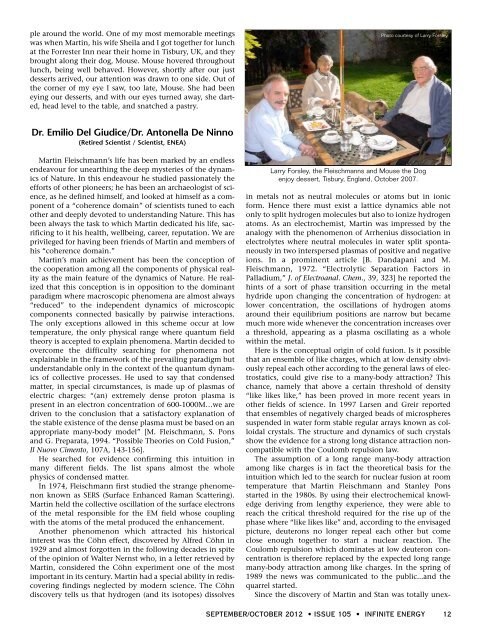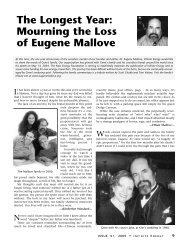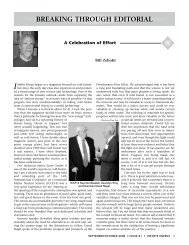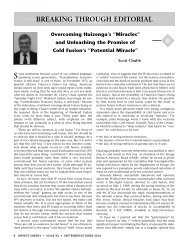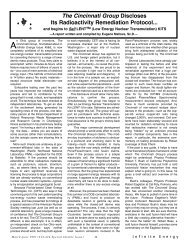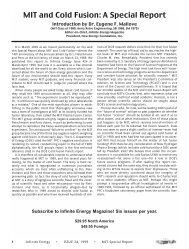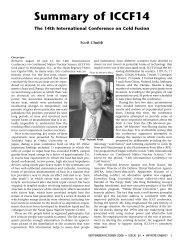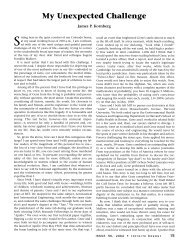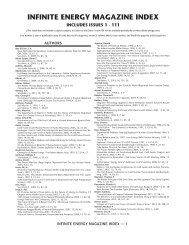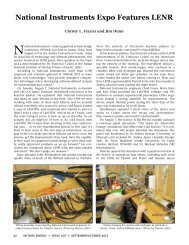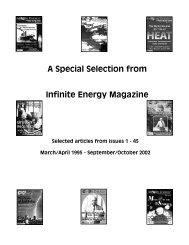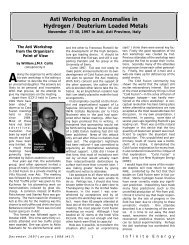Martin Fleischmann's Historic Impact - Infinite Energy Magazine
Martin Fleischmann's Historic Impact - Infinite Energy Magazine
Martin Fleischmann's Historic Impact - Infinite Energy Magazine
Create successful ePaper yourself
Turn your PDF publications into a flip-book with our unique Google optimized e-Paper software.
ple around the world. One of my most memorable meetings<br />
was when <strong>Martin</strong>, his wife Sheila and I got together for lunch<br />
at the Forrester Inn near their home in Tisbury, UK, and they<br />
brought along their dog, Mouse. Mouse hovered throughout<br />
lunch, being well behaved. However, shortly after our just<br />
desserts arrived, our attention was drawn to one side. Out of<br />
the corner of my eye I saw, too late, Mouse. She had been<br />
eying our desserts, and with our eyes turned away, she darted,<br />
head level to the table, and snatched a pastry.<br />
Dr. Emilio Del Giudice/Dr. Antonella De Ninno<br />
(Retired Scientist / Scientist, ENEA)<br />
<strong>Martin</strong> Fleischmann’s life has been marked by an endless<br />
endeavour for unearthing the deep mysteries of the dynamics<br />
of Nature. In this endeavour he studied passionately the<br />
efforts of other pioneers; he has been an archaeologist of science,<br />
as he defined himself, and looked at himself as a component<br />
of a “coherence domain” of scientists tuned to each<br />
other and deeply devoted to understanding Nature. This has<br />
been always the task to which <strong>Martin</strong> dedicated his life, sacrificing<br />
to it his health, wellbeing, career, reputation. We are<br />
privileged for having been friends of <strong>Martin</strong> and members of<br />
his “coherence domain.”<br />
<strong>Martin</strong>’s main achievement has been the conception of<br />
the cooperation among all the components of physical reality<br />
as the main feature of the dynamics of Nature. He realized<br />
that this conception is in opposition to the dominant<br />
paradigm where macroscopic phenomena are almost always<br />
“reduced” to the independent dynamics of microscopic<br />
components connected basically by pairwise interactions.<br />
The only exceptions allowed in this scheme occur at low<br />
temperature, the only physical range where quantum field<br />
theory is accepted to explain phenomena. <strong>Martin</strong> decided to<br />
overcome the difficulty searching for phenomena not<br />
explainable in the framework of the prevailing paradigm but<br />
understandable only in the context of the quantum dynamics<br />
of collective processes. He used to say that condensed<br />
matter, in special circumstances, is made up of plasmas of<br />
electric charges: “(an) extremely dense proton plasma is<br />
present in an electron concentration of 600-1000M…we are<br />
driven to the conclusion that a satisfactory explanation of<br />
the stable existence of the dense plasma must be based on an<br />
appropriate many-body model” [M. Fleischmann, S. Pons<br />
and G. Preparata, 1994. “Possible Theories on Cold Fusion,”<br />
Il Nuovo Cimento, 107A, 143-156].<br />
He searched for evidence confirming this intuition in<br />
many different fields. The list spans almost the whole<br />
physics of condensed matter.<br />
In 1974, Fleischmann first studied the strange phenomenon<br />
known as SERS (Surface Enhanced Raman Scattering).<br />
<strong>Martin</strong> held the collective oscillation of the surface electrons<br />
of the metal responsible for the EM field whose coupling<br />
with the atoms of the metal produced the enhancement.<br />
Another phenomenon which attracted his historical<br />
interest was the Cöhn effect, discovered by Alfred Cöhn in<br />
1929 and almost forgotten in the following decades in spite<br />
of the opinion of Walter Nernst who, in a letter retrieved by<br />
<strong>Martin</strong>, considered the Cöhn experiment one of the most<br />
important in its century. <strong>Martin</strong> had a special ability in rediscovering<br />
findings neglected by modern science. The Cöhn<br />
discovery tells us that hydrogen (and its isotopes) dissolves<br />
Photo courtesy of Larry Forsley<br />
Larry Forsley, the Fleischmanns and Mouse the Dog<br />
enjoy dessert, Tisbury, England, October 2007.<br />
in metals not as neutral molecules or atoms but in ionic<br />
form. Hence there must exist a lattice dynamics able not<br />
only to split hydrogen molecules but also to ionize hydrogen<br />
atoms. As an electrochemist, <strong>Martin</strong> was impressed by the<br />
analogy with the phenomenon of Arrhenius dissociation in<br />
electrolytes where neutral molecules in water split spontaneously<br />
in two interspersed plasmas of positive and negative<br />
ions. In a prominent article [B. Dandapani and M.<br />
Fleischmann, 1972. “Electrolytic Separation Factors in<br />
Palladium,” J. of Electroanal. Chem., 39, 323] he reported the<br />
hints of a sort of phase transition occurring in the metal<br />
hydride upon changing the concentration of hydrogen: at<br />
lower concentration, the oscillations of hydrogen atoms<br />
around their equilibrium positions are narrow but became<br />
much more wide whenever the concentration increases over<br />
a threshold, appearing as a plasma oscillating as a whole<br />
within the metal.<br />
Here is the conceptual origin of cold fusion. Is it possible<br />
that an ensemble of like charges, which at low density obviously<br />
repeal each other according to the general laws of electrostatics,<br />
could give rise to a many-body attraction? This<br />
chance, namely that above a certain threshold of density<br />
“like likes like,” has been proved in more recent years in<br />
other fields of science. In 1997 Larsen and Greir reported<br />
that ensembles of negatively charged beads of microspheres<br />
suspended in water form stable regular arrays known as colloidal<br />
crystals. The structure and dynamics of such crystals<br />
show the evidence for a strong long distance attraction noncompatible<br />
with the Coulomb repulsion law.<br />
The assumption of a long range many-body attraction<br />
among like charges is in fact the theoretical basis for the<br />
intuition which led to the search for nuclear fusion at room<br />
temperature that <strong>Martin</strong> Fleischmann and Stanley Pons<br />
started in the 1980s. By using their electrochemical knowledge<br />
deriving from lengthy experience, they were able to<br />
reach the critical threshold required for the rise up of the<br />
phase where “like likes like” and, according to the envisaged<br />
picture, deuterons no longer repeal each other but come<br />
close enough together to start a nuclear reaction. The<br />
Coulomb repulsion which dominates at low deuteron concentration<br />
is therefore replaced by the expected long range<br />
many-body attraction among like charges. In the spring of<br />
1989 the news was communicated to the public...and the<br />
quarrel started.<br />
Since the discovery of <strong>Martin</strong> and Stan was totally unex-<br />
SEPTEMBER/OCTOBER 2012 • ISSUE 105 • INFINITE ENERGY 12


